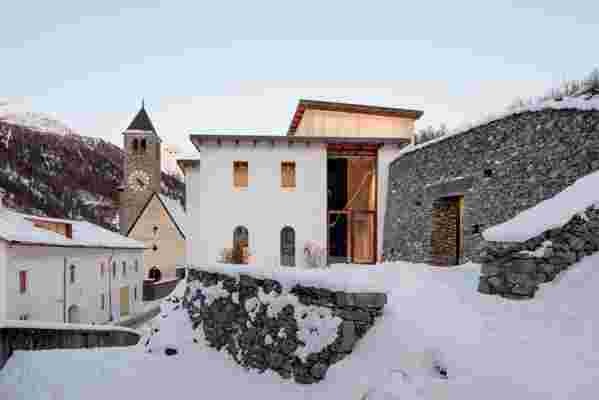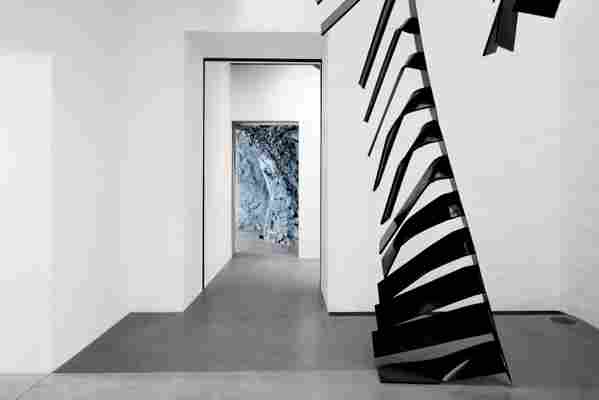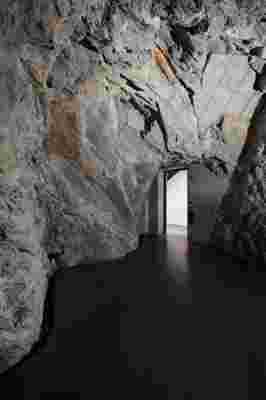June 10,2022
This Mountainous Swiss Monastery Has Transformed Into a Contemporary Art Museum
by David Stewart
There’s a lot to gawp at in the new galleries of Muzeum Susch—a meticulous white cube space carved out of a 19th-century brewery, which flows, in less than 300 feet, across ten centuries—but a strange Art Deco mural stands out. Upon closer inspection, the painting turns out to be an engraving, the result of a nail scraped against a wall for countless hours, its metallic remains permanently tattooed into the flesh of the building. Known as sgraffito, this grueling exercise is an old tradition in Swiss culture; most buildings in old mountain villages like Susch flaunt its whimsical charm. In many ways, the Muzeum’s evolution from a dilapidated 12th-century monastery to a new pilgrimage site for contemporary art can be understood as a similar act of creation.
Helmed by the Polish billionaire entrepreneur Grażyna Kulczyk, Muzeum Susch is the result of five years of calculated incisions into an age-old structure still saturated with human memory. While some interventions were literally explosive—such as blasting some 9,000 tons of amphibolite, the local mineral rock, beneath and beside the brewery in order to make room for the 16,000 square feet of new gallery space—others are so minimal that one would barely notice the difference. "A good rule of thumb is to mind the gap: Any space or shift between materials indicates a transformation," explains Chasper Schmidlin . It was the young duo, Chasper Schmidlin and and Lukas Voellmy who worked on the space (they also previously designed the Von Bartha Gallery in Basel).
But with a material tool kit that includes repurposed amphibolite and plaster made from hand-ground stones sourced from the nearby Flüela Pass river, the raw tactility of the building and its labyrinthine layout override any need to distinguish between old and new elements. With this range of treatment, the Muzeum invokes its own almost human persona, perhaps inherited from the local carpenters, metalworkers, mills, and sign painters who collectively brought it to life.

The team used various techniques, including the use of explosives, during the redesign to make room for the 16,000 square feet of new gallery space.
The small village of 220 year-round residents was once a crucial pit stop in the ancient pilgrim route to Santiago de Compostela (the supposed burial site of the biblical apostle St. James), and the old brewery offered a rare evening of revelry amid an otherwise exhausting quest. Susch was a global hot spot for hops, with the river flowing just outside what is now the Muzeum once serving as opening point for a vast distribution network of its home-brewed beer.
The architects have taken great care to preserve this legacy as a convergence of both human and natural histories. Within the gallery space housing Jaroslaw Kozlowski’s sprawling piece Books, Words, Ideas (2018), fresh foundations wrap around the original horse trough and chute from the building’s pilgrimage days, paying homage to these old relics while enabling the building to take on a new function.

Stairs (2016–17), by Polish artist Monika Sosnowska.
New skylights and a generous extension fill the 45-foot-tall cooling tower of the brewery, where the monumental black steel sculpture by Polish artist Monika Sosnowska titled Stairs (2016–17) cascades over the centralized balconies of all three floors. Easily spied from multiple gallery rooms, its squiggling tendrils gleefully reject its utilitarian title, instead becoming the symbolic spine of the Muzeum. “Most museums position the staircase as the core of the building,” explains Voellmy. “We focused on spaces rich in history that create a slow art experience.”
Nowhere is this more evident than where Mother Nature gets the upper hand. Entering the narrow hallway that offshoots from the Muzeum’s low-key entrance, visitors come face to face with a jagged wall of wet amphibolite. The stone, exposed to oxygen for the first time in millennia, has already started to crystallize, its milky residue creating a sort of indoor snow. Even more epic in scale is the “weeping room” adjacent to the sparkling new gallery space, doubled in height and dramatically lit by the architects; water flows freely over this glistening grotto. Intentionally lacking in art, it instead becomes a space for deeper contemplation—and later on in the year when the snow finally melts, a place for the river to reclaim, suggest the architects.

A look at how the new gallery space was built into the rock formation that surrounds it.
Ironically, the most luxurious details of the project—such as the polished terrazzo floorings, the wood-paneled galleries and cloakrooms, and the slick metal staircase in the room adjacent to the "spine"—are of the humblest origins, both locally sourced and manufactured, thanks to the extensive efforts of the architects. “Having the people of Susch involved throughout the past five years has established a sense of pride and communality in the Muzeum,” says Schmidlin.
Known for supporting promising talent over big-name artists as a collector, Kulczyk evidently follows the same path in architecture: “Why would I hire a starchitect if I could work with a pair of young, enthusiastic, local architects who know the area and what its people need?” she asks. It is a refreshing question to hear, one that has resulted in an enchantingly unique museum that’s deeply rooted in local history and the global edge of contemporary art, both forces flowing like a river wherever you look.






